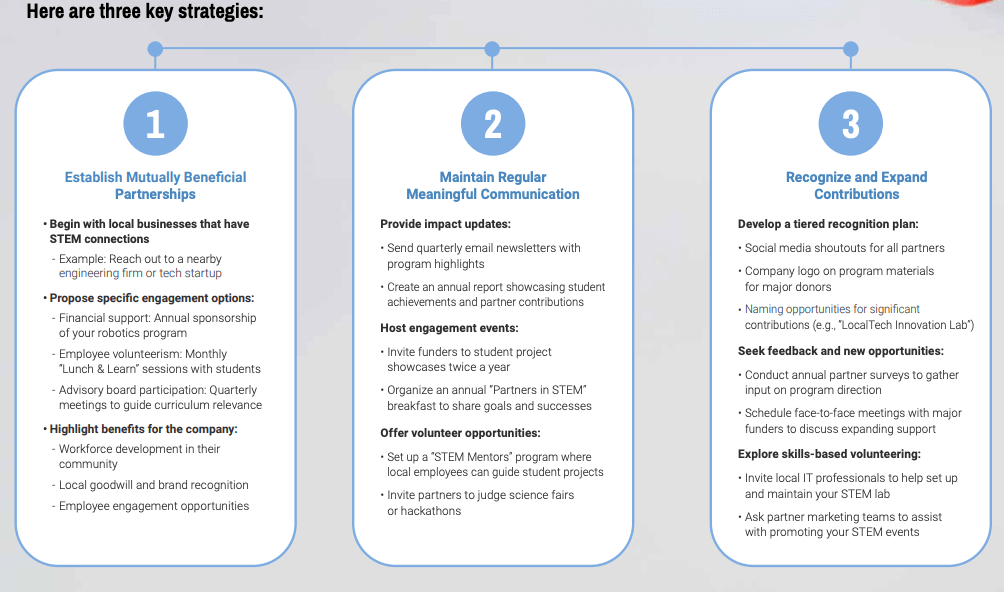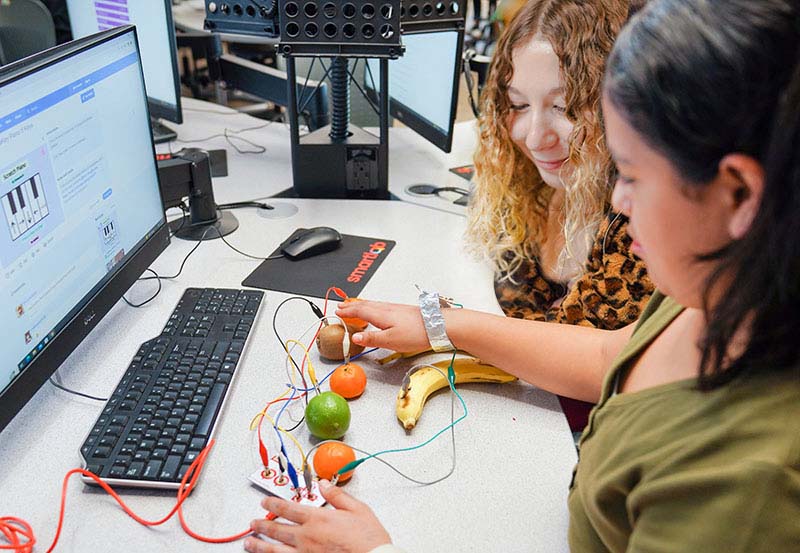Education Grants: Your Guide To Securing Funding
Education grants are an invaluable resource for all schools — kindergarten through high school, public and private alike — as they provide important financial support to address budget shortfalls, fund critical projects, and promote educational excellence.
Grants are a crucial support system, whether you’re a teacher looking for more classroom supplies for your elementary students, a high school principal hoping to install new learning technology, or a district that wants to do more to reach underserved communities. One of the best reasons for pursuing a grant is that, unlike loans, they don’t need to be paid back if the funds are spent in accordance with the terms of the award.
Even if you’re not actively pursuing a grant, it’s important to understand your options, including federal funding, state funding, nonprofits, and private funding. At SmartLab, we’ve worked with many educators and districts as they searched, applied for, and utilized education grants. Here’s what you need to know about how to find grants, land those opportunities, and explore your funding options.
What Educators Need to Know about Grant Money for Schools
While most government and private grants for education are targeted toward public schools and districts (also referred to as Local Education Agencies or LEAs), grants do exist for both nonprofit and for-profit private schools. The most important step in securing grants for private schools or for public education is to determine if you’re eligible.
- First, decide if you’re applying as an individual educator or if you’ll be representing a larger organization, such as a club, department, or even your entire school or district. Once you know this, you’ll need to check your eligibility to apply.
- All grants have a section in the official grant announcement explaining eligibility. To determine your eligibility, you’ll need to review the requirements of who the grant was established for and what the money will be used for:
- Most grants are established to help public schools cover costs and support the educational experience — especially those schools with at-risk or low-income student populations.
- Nonprofit schools, especially those with 501(c)(3) status, also are generally eligible for a higher number of grants.
- Private and for-profit schools will have the fewest grant options to apply for, but opportunities do exist. These schools just may have to work a little harder to establish their eligibility.
- If you are a school that is a part of an LEA or district, check with your principal to determine which grants are acceptable to apply for. This is especially true if the grant affects elements like staffing, professional development, investments in technology, or other resources for the district since applying for the grant could complicate other funding efforts. Your LEA may have funding restrictions or limitations, so be sure to check and secure approval before making any applications.
- Note that some grants also require the LEA to be the lead fiscal agent, which is the organization that agrees to accept and maintain responsibility for grant funds on your behalf. In this case, school principals are often able to liaise with school district officials to secure approval to apply for the funding. For more details on fiscal agents, see this overview from the NEA Foundation.
- In addition to the grant guidelines and eligibility criteria, you also want to research the deadlines. Grants submissions may require additional documents, attachments, or other forms. You don’t want to wait until the last minute to submit in case there are any oversights or technical issues.

Tips for Applying to Education Grants
Have you found a grant that you’d like to apply to? Here’s some helpful tips and advice.
- Carefully consider your eligibility for the grant and take the time to consult with the school principal. If you are not eligible for a specific funding opportunity, or if there is some conflict with the LEA, then you will waste a lot of time and money completing the application process.
- Start your grant application with an understanding of what you’re trying to achieve. You want to clearly articulate your goals, objectives, and expected outcomes. Tailor your proposal to address the grantor’s priorities and demonstrate how your project aligns with their objectives.
- Understand that grants follow a linear life cycle that goes beyond the application process, some of which will have additional requirements and responsibilities. Generally speaking, there are three phases:
- Pre-Award Phase — This is the period of time after the deadline has passed and the organization starts to make its award decisions. Some may even request interviews or site visits as part of the evaluation process. Be prepared to talk more about your proposal and provide additional material as needed.
- Award Phase — This is when the organization sends out the official award decisions and notifications. If your application is not successful, consider requesting feedback from the grantor to improve your future applications. If you are awarded the grants — congratulations! When you accept, you are obligated to carry out its full terms and conditions.
- Post-Award Phase — Depending on the grant, there can be a significant amount of work after the award. Be aware that some grants require a rigorous amount of data and reporting that have to be recorded and reported. The terms and conditions of the grant may also require audit(s) and the submission of a final report detailing how the funds were spent.
- To expand on that last point, you’ll want to be aware of the full responsibilities of reporting after an award has been granted. Depending on the post-award requirements, you and other school representatives may have to make a significant investment of time and effort, sometimes for years down the line. Make sure you know what you’re signing up for.
Understanding Blending and Braiding
Maximizing support for STEM initiatives often requires combining multiple funding sources. Two key strategies for this are blending and braiding. These approaches can significantly enhance your STEM program’s financial stability and scope.
Blending: Combining funds from multiple sources into a single, unified pool to support a program. For example, merging Title IV funds with local tech company donations to create a state-of-the-art STEM lab.
Braiding: Coordinating multiple funding sources, each with its own set of regulations, to support a single initiative while maintaining distinct tracking and reporting for each source. For example, using Title I funds for low-income student support and corporate grants for equipment in the same STEM program.
You can find more detailed information about education grants at Grants.gov, including definitions of terms, overviews of processes, and details on grant programs. As to where to find the grants themselves, we’ve broken them down into five major categories of funding:
- Federal
- State
- Nonprofits
- Private
- Other
You don’t have to do it all yourself. Download the SmartLab Sustainable STEM funding guide here, and let us know if you’d like help from a specialist to fund your SmartLab.
Federal Grants and Funding
As the largest supplier of government grant money for schools, the U.S. federal government has several departments, agencies, and foundations that offer financial assistance. There are federal grants for state and local educational agencies, K-12 schools, community and faith-based organizations, and other entities involved in education.
Explore the following federal grant opportunities:
- National Science Foundation (NSF): This independent federal agency is one of the primary funding agencies for scientific research and education in the United States. The primary goals of the NSF are to advance scientific knowledge, foster innovation, and promote STEM education in the United States. NSF grant resources include:
- U.S. Department of Education (DoE): This department oversees and implements federal education policies, programs, and initiatives across the United States. The DoE administers a significant portion of federal funding for education and awards grants to states, school districts, educational institutions, and nonprofit organizations to support a wide range of educational initiatives, including teacher training, literacy programs, and school improvement efforts.
- Office of Elementary & Secondary Education: This office of the United States Department of Education (OESE) is responsible for overseeing federal programs and policies related to elementary and secondary education. One of the main roles of the OESE is distributing federal funding to support K-12 education. Following the COVID-19 pandemic, the OESE was responsible for overseeing The Elementary and Secondary School Emergency Relief (ESSER) funds in support of students’ social-emotional well-being and academic achievement. While ESSER funds are no longer available, the OESE offers other programs and grants for K-12 funding.
It’s important to note that though federal grants are widely available — or perhaps because they’re open to such a broad range of schools — they are often not the first choice for government grant money. Some federal grants may have requirements that aren’t applicable to your state, such as meeting Common Core standards, or lack the specific assistance needed to reach a state’s unique student population. That’s why it’s recommended to look into regional and local options, such as what’s offered by your state government.ptions, such as what’s offered by your state government.
State Grants and Funding
Many states recognize the importance of STEM education and offer targeted grants to support these initiatives. Understanding and leveraging these opportunities can significantly boost your STEM program.
Common State STEM grant categories include:
- Equipment and Technology: Funding for lab equipment, computers, and software
- Teacher Professional Development: Support for STEM-focused training and workshops
- Curriculum Development: Resources to create or enhance STEM curricula
- STEM-Focused Programs: Grants for extracurricular activities like robotics clubs or coding classes
Start your search on the website of your state’s department of education for details about available grants and other sources of funding. Generally they do a good job of consolidating all grants that are available through the state’s DoE or are available for LEAs within that state. For example, in SmartLab’s home state of Colorado, many schools apply for the BEST Grant Program to help renovate, update, and build schools and classrooms.
Securing state funding is crucial for sustaining your STEM programs, but it does require consistent attention and effort. Districts should designate specific roles to oversee and manage funding. See The Grantsmanship Center for an overview of specific grant resources on a state-by-state basis.
After you’ve explored what’s available on the state level, your next step should be to see what’s available in terms of nonprofit and private grants.
Nonprofit Grants and Funding
There are many philanthropic and nonprofit organizations that offer grants and funding for education. Be aware that many of these grants tend to be on a smaller scale when compared to government education grants, with a limited amount of funds that range anywhere from a few hundred to a few thousand dollars. One single nonprofit grant may not be enough to fund your initiative, so be sure to understand the scale of what you’re trying to achieve and the total amount of funding your project requires.
These grants tend to have very specific requirements as well, so you’ll want to have a clear idea of your initiative to narrow your search and point you in the right direction. There’s no set timeline for these grants; some may be awarded annually, while others may be one-time opportunities, so you’ll want to conduct regular searches to see what’s available.
Here are some of the major grants offered by well-established nonprofit organizations:
- American Association of Educators Scholarships and Grants
- American Association of School Librarians Innovative Reading Grant
- NEA Learning & Leadership Grants
- McCarthey Dressman Education Foundation Teacher Development Grants
- Gravely and Paige Grants for STEM Teachers
- Fund for Teachers
For further exploration, visit grant funding aggregate sites like GrantWatch.
Private Grants and Funding
Corporations and private enterprises also have charitable programs where they give back to their communities, many of which can apply to education. One side benefit of utilizing private funding is that it can be a great source of publicity or marketing for your school. It can be an efficient way to connect with local businesses and organizations and members of the community.
Local funders are often easier to meet with and are more likely to be invested in community outcomes. A successful partnership with one local company can serve as a powerful example to attract larger sponsors. Consider these three key strategies on how to establish, maintain and grow your relationships with businesses and corporations:

Like nonprofit education grants, there’s no set timeline or consistency to private grants. Conduct regular searches or consult with the school’s principal or a member from the LEA for leads. The following are examples of grants for schools offered by major national corporations:
Some organizations that SmartLab has worked with include:
- Gill Foundation — A leader in funding for equity in schools with a mission to secure equality for LGBTQ students.
- Success Foundation — A private donor committed to advancing PK-12 education in the 6th congressional district of Colorado.
- Campos EPC — Headquartered in Denver, Campos EPS is dedicated to supporting future engineering and construction professionals.
- MidAmerica Industrial — This Tulsa, Oklahoma industrial park is invested in providing local students with skills needed for the workforce.
For more information on these private donors and other funding partners we’ve worked with, see the SmartLab page on education grants and other funding opportunities.
Other Sources of Funding
While grants are the most popular and largest sources of funds for education, they aren’t your only options. Other approaches can help provide additional funding, especially when part of a blended or braided approach.
Crowdfunding
Thanks to the rise of digital technology, crowdfunding has gained in popularity and viability as a legitimate and successful fundraising process. Online campaigns are an increasingly valuable tool for raising money and building a network of support. However, money from crowdfunding tends to be more limited than established grants, as there’s no guarantee of what the funding amount will be, which makes it a good source of funding for smaller scale projects, but not ideal for larger goals.
Popular crowdfunding sites include:
Self-sustaining Entrepreneurship
Self-sustaining entrepreneurship puts a STEM-twist on the traditional student fundraising. Instead of selling baked goods or magazine subscriptions, students create and sell their own STEM-related products or services. Students might sell 3D-printed mascots or laser-cut keychains at events, design educational apps, or offer tech support services and workshops within the community. This model not only supports program funding but gives students practical business experience.
Alumni Contributions
Reaching out to school alumni for donations and contributions can help support projects and infrastructure improvements. Developing and maintaining a robust alumni network takes time and effort, as well as constant communication. Organizing outreach for donations and hosting fundraising events can raise a program’s profile within the community while bringing in funds.
A little ingenuity can help you secure funding when other options aren’t available. Read this case study to see how one educator at a private school was able to get creative and fund a new SmartLab for her learners.
Consider a STEM Advisory Board
Securing grants requires a coordinated and sustained effort. It’s a lot of work for educators to take on alone, so establishing a well-structured STEM advisory board can really help in fostering partnerships and advocating for funding
Composed of 8-12 diverse members from industry, education, and community, a STEM advisory board would offer direction in:
- Aligning the program with workforce needs — Board members from industry can provide insights on skills gaps, emerging technologies, and job market trends, helping shape curriculum to meet real-world demands.
- Providing real-world connections for students — Board members can open doors to their companies and networks, facilitating job shadows, guest speakers, and collaborative projects that bring STEM concepts to life.
- Assisting with fundraising and grant writing — Members can identify grant opportunities, provide letters of support, and leverage their professional networks to secure financial resources and in-kind donations.
- Organizing impactful STEM events — Tap into board members’ expertise to design authentic challenges, secure industry judges, and create events that showcase student skills to the broader community.
Education Grant FAQs
What types of grants are available for public schools?
Education grants for public schools can come from federal, state, and local government sources, as well as private foundations and organizations. The availability of specific grants may vary depending on factors such as the school’s location, student demographics, and educational goals.
Is my private school eligible for funding and grants?
While most education grants are intended for public education or nonprofit organizations, private and for-profit schools do have options for funding and grants. Check with your local education foundations for upcoming funding opportunities.
Can I apply for multiple types of grants?
Yes, you don’t have to rely on just one source for your grant money. Rather than trying to secure all your funding from one grant, it’s pretty common to apply to multiple grants from different sources. You can take what’s called a “blend and braid” approach by combining two or more funding streams.
- Braided funding combines multiple funding streams toward one purpose while separately tracking and reporting on each source of funding.
- Blended funding combines multiple funding streams for one purpose and does not differentiate or track individual sources.
What federal grants is my school eligible for?
Your school’s eligibility for federal grants will vary based on factors such as the school’s location, student population, and specific needs. To see which grants you may qualify for, start by visiting the websites of federal grant programs that are commonly available to public schools, such as the U.S. Department of Education’s Grant Programs webpage and Grants.gov.
What private grants is my school eligible for?
There are a lot of private grant opportunities for schools, and they change every year. Start by researching private foundations, corporations, nonprofit organizations, and community groups that offer grants in the field of education. Consider visiting the Foundation Center’s Foundation Directory to start your search.
Talk to SmartLab about Creating Opportunities for STEM Grants
Over the past few years there has been a shift in beliefs about the purpose of STEM education. The need isn’t to prepare students for STEM-specific jobs but to help them develop STEM literacy. Grants are an essential resource in securing the technology and educator training necessary to teach these modern skills to students.
One of the best ways to help your students master the skills of tomorrow is with a SmartLab, which provides STEM learning environments and curricula founded on project-based learning principles. A grant can help you secure the funding you need to make this opportunity a reality and help alleviate the cost of installation.
Ready to get started? Contact us today for more information and to take the first steps on your next educational partnership.
Note: This article was originally published in 2023 by Donvan Goode, SmartLab VP of Sales from Oct 2021 – Sep 2024 and was updated in Dec 2024 by Annie Burnett, who began her role as SmartLab’s VP of Partnerships in March, 2024.





